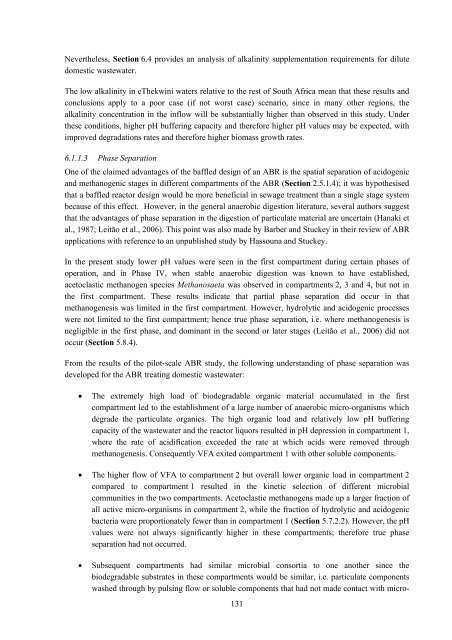analysis of a pilot-scale anaerobic baffled reactor treating domestic ...
analysis of a pilot-scale anaerobic baffled reactor treating domestic ...
analysis of a pilot-scale anaerobic baffled reactor treating domestic ...
Create successful ePaper yourself
Turn your PDF publications into a flip-book with our unique Google optimized e-Paper software.
Nevertheless, Section 6.4 provides an <strong>analysis</strong> <strong>of</strong> alkalinity supplementation requirements for dilute<br />
<strong>domestic</strong> wastewater.<br />
The low alkalinity in eThekwini waters relative to the rest <strong>of</strong> South Africa mean that these results and<br />
conclusions apply to a poor case (if not worst case) scenario, since in many other regions, the<br />
alkalinity concentration in the inflow will be substantially higher than observed in this study. Under<br />
these conditions, higher pH buffering capacity and therefore higher pH values may be expected, with<br />
improved degradations rates and therefore higher biomass growth rates.<br />
6.1.1.3 Phase Separation<br />
One <strong>of</strong> the claimed advantages <strong>of</strong> the <strong>baffled</strong> design <strong>of</strong> an ABR is the spatial separation <strong>of</strong> acidogenic<br />
and methanogenic stages in different compartments <strong>of</strong> the ABR (Section 2.5.1.4); it was hypothesised<br />
that a <strong>baffled</strong> <strong>reactor</strong> design would be more beneficial in sewage treatment than a single stage system<br />
because <strong>of</strong> this effect. However, in the general <strong>anaerobic</strong> digestion literature, several authors suggest<br />
that the advantages <strong>of</strong> phase separation in the digestion <strong>of</strong> particulate material are uncertain (Hanaki et<br />
al., 1987; Leitão et al., 2006). This point was also made by Barber and Stuckey in their review <strong>of</strong> ABR<br />
applications with reference to an unpublished study by Hassouna and Stuckey.<br />
In the present study lower pH values were seen in the first compartment during certain phases <strong>of</strong><br />
operation, and in Phase IV, when stable <strong>anaerobic</strong> digestion was known to have established,<br />
acetoclastic methanogen species Methanosaeta was observed in compartments 2, 3 and 4, but not in<br />
the first compartment. These results indicate that partial phase separation did occur in that<br />
methanogenesis was limited in the first compartment. However, hydrolytic and acidogenic processes<br />
were not limited to the first compartment; hence true phase separation, i.e. where methanogenesis is<br />
negligible in the first phase, and dominant in the second or later stages (Leitão et al., 2006) did not<br />
occur (Section 5.8.4).<br />
From the results <strong>of</strong> the <strong>pilot</strong>-<strong>scale</strong> ABR study, the following understanding <strong>of</strong> phase separation was<br />
developed for the ABR <strong>treating</strong> <strong>domestic</strong> wastewater:<br />
• The extremely high load <strong>of</strong> biodegradable organic material accumulated in the first<br />
compartment led to the establishment <strong>of</strong> a large number <strong>of</strong> <strong>anaerobic</strong> micro-organisms which<br />
degrade the particulate organics. The high organic load and relatively low pH buffering<br />
capacity <strong>of</strong> the wastewater and the <strong>reactor</strong> liquors resulted in pH depression in compartment 1,<br />
where the rate <strong>of</strong> acidification exceeded the rate at which acids were removed through<br />
methanogenesis. Consequently VFA exited compartment 1 with other soluble components.<br />
• The higher flow <strong>of</strong> VFA to compartment 2 but overall lower organic load in compartment 2<br />
compared to compartment 1 resulted in the kinetic selection <strong>of</strong> different microbial<br />
communities in the two compartments. Acetoclastic methanogens made up a larger fraction <strong>of</strong><br />
all active micro-organisms in compartment 2, while the fraction <strong>of</strong> hydrolytic and acidogenic<br />
bacteria were proportionately fewer than in compartment 1 (Section 5.7.2.2). However, the pH<br />
values were not always significantly higher in these compartments; therefore true phase<br />
separation had not occurred.<br />
• Subsequent compartments had similar microbial consortia to one another since the<br />
biodegradable substrates in these compartments would be similar, i.e. particulate components<br />
washed through by pulsing flow or soluble components that had not made contact with micro-<br />
131
















